
Index |
Next |
Prev |
Computers & Surround Sound
Martian Numerals
Computers & Surround Sound
1:00am, Tuesday, May 20, 2014
Current mood: numb ![]()
No doubt home cinema surround sound is a great thing when it works as advertised... If you have set up your speakers correctly and have connected your Blu-ray player to your properly configured AV receiver via HDMI and then connected your receiver to a large, hi-res, flat-screen TV that has been accurately calibrated, also via HDMI, then you will most probably be "happy as a pig in shit". You should have a smooth moving, high resolution image with pretty much the colours and contrast that the director intended and a super hifi audio image that covers the room and gives you the audio experience that the director intended. Magnificent!
![]()
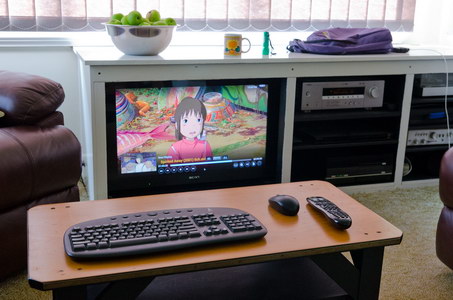
My multimedia PC playing a 5.1 channel AVI file through my AV receiver in Dolby Digital (click for full res).
The PC is the black box on the bottom shelf on the right. The stand-alone BluRay player is above it.
This is all well and good and more than difficult enough for the ordinary human to set up but at least they have a chance at getting it right... probably most will fail though... the screen calibration is clearly beyond most humans... Still, it's at least possible and for the geek it's relatively straight forward.
![]()
The REAL problem occurs when you introduce your computer into the home entertainment centre. It's a GREAT idea: an "Entertainment PC"... It already has all the necessary hardware: surround sound built into the motherboard offering output in discrete 6 cable analog or single cable digital S/PDIF via optical or coax, high resolution video via VGA interface from your graphics card and wired or wireless keyboard and mouse. You may even be able to simplify everything with a single HDMI cable. Your PC already stores and plays all your music, it surfs the net perfectly, it plays video games, it downloads and plays movies, it displays your photos and it can stream TV shows and other content from the web. It can even play DVDs and BluRays. All you have to do is shove it into the heart of your entertainment unit, connect it up and you'll be enjoying a first class surround sound experience immediately!

I had an old Athlon PC that I had dedicated as a multimedia PC about 5 years or so ago. It had a creative Live 5.1 sound card and an nVidia 5200 graphics card and plenty of hard disc and memory so it should have done the job easily. However the digital surround output of the sound card NEVER worked, despite Creative's assertion that it did. I spent considerable time on the problem and bought their official TOSLINK adapter. It was all a waste of time as this issue and various other issues on other Creative cards convinced me beyond all doubt that Creative Technology SIMPLY CAN'T WRITE DRIVERS and therefore THEIR SOUND CARDS ARE USELESS! It's not just my experience, you need only surf the net to find the litany of frustration, disasters and insoluble bugs that riddle their products. NEVER have I seen such a torrent of abuse directed at one company as when I read their forums 5 years ago. I have bought a number of their cards in the past but I will NEVER buy one again!
![]()
As my AV receiver couldn't handle the discrete analogue outputs I eventually gave up on the whole business and just used stereo sound, which was not entirely satisfying. Then the old motherboard and CPU developed overheating problems and program bloat and creeping inefficiencies meant that what was once a fine computer could no longer even surf the net and I had to remove it from service.
![]()
I was looking for the opportunity to upgrade this outdated machine and so when I found the time and money I bought a new motherboard and bits for my desktop and passed its trusty Core II Duo guts down to the multimedia PC. I also upgraded the power supply, put a BluRay burner in and installed a solid state drive instead of the mechanical drive to help keep the heat down. The upgraded entertainment system now sported S/PDIF via TOSLINK on the motherboard and a Radeon 6670 graphics card. No Creative bullshit and plenty of video grunt!
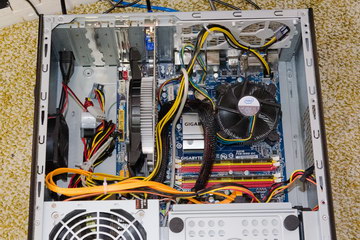
The guts of my upgraded multimedia PC.
I thought I'd be smart and attempt to break away from the loved/hated Windows 7, so I installed Ubuntu (Trusty Tahr) which is a story in itself. There were a few hurdles to overcome but quite soon I had some lovely stereo sound coming through my AV receiver with a clarity that I had not been able to achieve before, except by using the stand alone BluRay unit. It was a great joy and I then sought to get the 5.1 channel surround sound that I had been promised. I was running the excellent VLC as my player and I could see from the CODEC information that the video files I was playing were 5.1 channel AC3 and DTS, yet the receiver showed only stereo. I checked the audio setup and found that the system was configured for stereo. The problem was that THERE WAS NO OPTION TO SELECT SURROUND! WTF? I surfed the Ubuntu forums and found the suggestion that running the ALSA mixer from the terminal could solve the problem. I was highly skeptical but I ran it and YES, I was able to configure the setup as 5.1 channel. VOILA! I had surround sound!
![]()
Suddenly I had an Entertainment System that worked the way it was intended. The clarity, definition and spatial accuracy of the sound from the media files that I was accessing from my NAS box seemed as good as from my stand alone BluRay unit! Bliss! I was amazed that modern video encoding could produce a file of less than 2GB whose audio and video quality, from the couch, was virtually indistinguishable from a BluRay disc of up to 50GB! A 25:1 compression factor with, (from a distance), no serious loss in quality! Incredible! We watched a number of movies over the next few days and the enjoyment and amazement continued. Here was what I had dreamed of from the beginning!
Alas, within a week Ubuntu let me down in a number of ways: it stopped handling my wireless mouse, it didn't allow keyboard control of the stupid Unity Panel, it stopped playing surround sound, it stopped recognising the network and it prevented the Windows dual boot. I can't put up with an untrustworthy operating system and I had to repartition and reformat the drive and reinstall Windows 7. Goodbye Ubuntu, you showed good potential but you still aren't ready for serious use... Will you ever be?
![]()

Ubuntu 14.04 (the Trusty Tahr) - Sadly guys, it let me down.
With Windows 7 on my PC I installed VLC and found the same problem that surfaced with Ubuntu: I couldn't configure the Audio setup as surround. The problem here is with the Audio Manager supplied by RealTek for their HD Audio chip. The pests at RealTek have taken the control away from the user. Presumably the RealTek hardware senses the capabilities of your audio system automatically and only provides the configuration options that it THINKS you have available. The fact that your actual setup might be quite different from that which the damn card senses presumably never entered the tiny minds of the FOOLS that wrote the RealTek Audio Manager. It is NOT excusable that a company should produce software that prevents its customers from being able to employ the device in the manner that was intended! When you consider how many man-years of effort have been wasted, and how many millions of customers have been frustrated and been forced to endure a system without correct sound for years, simply because a few programmers were too incompetent, lazy or arrogant to put the manual option into their software, you can see that their crime might well merit time in jail. This is a problem that has been around since at least 2010. Have RealTek addressed it? NO!
![]()
It took me at least a day of research and fruitless experimentation before I eventually cracked the problem by playing a BluRay disc through VLC. Lucky I had installed such a unit and lucky I was able to get it to play, as it is not straight forward. Somehow the BluRay disc alerted the Audio Manager and I was able to setup 5.1 channel surround sound. Eureka! I should have been happy but I was too worn out, disillusioned and disgusted to enjoy it that night.
The next day I experimented with the now working surround sound. Fantastic! It sounded as good as it had under Ubuntu. However there was one more problem: Dolby Digital and DTS worked perfectly but AAC was only in stereo at the receiver even though it was 5.1 in VLC. WTF was going on there?
![]()
After exhaustive research that took all the next day, I found that NO AV receiver supports AAC decoding. They support it streamed AFTER it has been decoded but NOT in its natural form. The most common downloadable surround sound video files at the time of writing are MP4 and use AAC encoding. Media players on a range of devices all read it happily BUT NOT AV RECEIVERS! Seriously guys: Get your fucking shit together! This is a compete joke! Obviously I am not going to buy a receiver that can't play the most common video format and neither is anybody else who understands this simple fact. So you aren't going to sell any are you? You bunch of visionless, rudderless cowards!
![]()
Once you understand that the problem is not your configuration nor your hardware and that it can't be solved by buying a new receiver, your choices are simple: convert all your AAC files to DTS or AC3 and then play them or transcode the digital audio stream on the fly.
I wasted another whole day experimenting with numerous video converter programs both free and trial versions of paid apps. Some were infantile, some were loaded with options, some were chock-a-block with intrusive ads and demands for donations and some were hopelessly inefficient. Nevertheless they all had one thing in common: NOT ONE CONVERTER WOULD CONVERT 5.1 CHANNEL AAC AUDIO TO DTS AND LEAVE THE VIDEO UNTOUCHED FOR ALL COMMON CONTAINER FORMATS! What a farce! And they expect you to pay them for such rubbish!
![]()
Having realised that converting existing files in a sane manner is not possible you are left with only one solution: transcoding on the fly. And since there is only one serious product that will do this you have no alternative but to install XBMC. This I did and after struggling through their irritating 10' interface I DID manage to setup the player to transcode on the fly from AAC to AC3 (Dolby Digital). And THEN there was light!
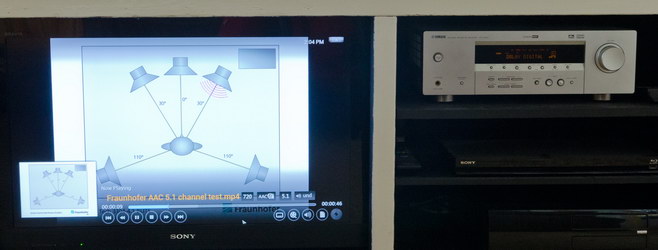
Proof that XBMC does transcode AAC 5.1 to Dolby Digital 5.1 on the fly (click to enlarge).
I have to say that I don't like XBMC's interface. It is inefficient, poorly focused and clumsy. There are numerous options missing and navigation is a pain. The output at times can seem overly sharp and saturated but by gum it DOES work! Kudos to the team!
![]()
I can now enjoy TRUE digital 5.1 channel surround from DTS, Dolby Digital and AAC encoded video files. If I can download it I can play it. That's NOT something I could do previously. It's been a long and painful journey to get to this point with much swearing and gnashing of teeth but hopefully it will continue to keep me happy for years to come and hopefully others that read this adventure will be able to take the short cut to satisfaction.
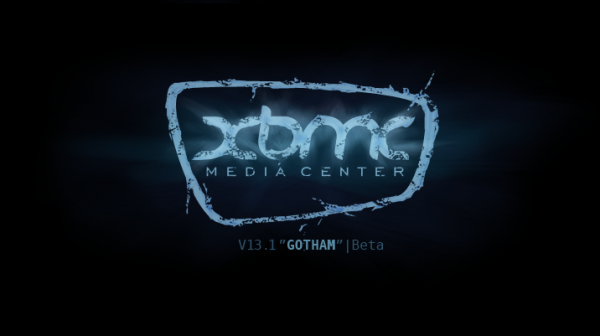
XBMC Gotham - The Solution
Currently watching:
Fight Club by David Fincher
Martian Numerals
9:30pm, Wednesday, September 9, 2014 (not really, this was when I should have written it, it was actually written in Jan 2015).
Current mood: calm ![]()
In August this year my friend James joined the Dozenal Society which exists to push for a change in our counting system from base 10 to base 12. I support the idea as 12 has more factors than 10 and would therefore be a little easier to use in everyday life. HOWEVER: Can you really imagine the entire human civilisation changing their culture and rewriting EVERY book and article containing a number greater than 9? It ain't gonna happen!!!
![]()
Anyway, I was interested in the glyphs they had chosen to represent our 10 and 11. (You can't use the existing glyphs 10 and 11 since in base twelve they correspond to 12 and 13.) They used a couple of squiggles that seemed completely out of character with the "Hindu-Arabic numerals" used throughout the "West" today. (Incidentally our "Hindu-Arabic numerals" are quite different in some cases from their parents and don't even line up correctly, but that is another story.) I commented on this glyph harmony problem to James and opined that I thought I could do better. I also mentioned that 12 glyphs was not enough, as all computer scientists use the base sixteen number system daily. 16 glyphs are need for this.
My friend responded with Bruce Martin's hexadecimal notation. "Pffft!" I said. "I'll produce a better system than that before breakfast!" Now Bruce Martin's scheme is actually not too bad, but nonetheless I took on the challenge.
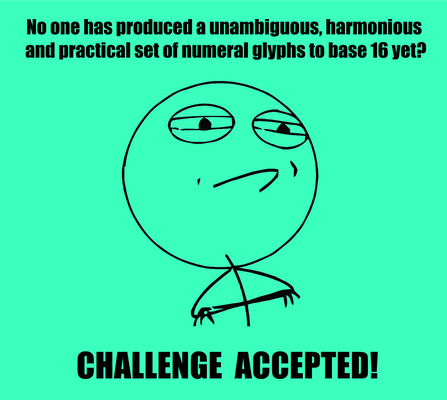
Runic System
The Bruce Martin hexadecimal notation is based on the nice and intuitive idea of horizontal strokes arranged in a binary format but it has 2 problems:
- The glyph for zero is out of character with the rest of the scheme.
I corrected this by making the traditional symbol for one the symbol for zero and discarding the traditional symbol for zero, "0", altogether. The world will be better for this as the glyphs for zero and oh: "0" and "O", are virtually identical and cause much confusion on a daily basis.
I am not bothered by the fact that the traditional symbol for one has changed its meaning. This will not cause the confusion you might expect as people will immediately see that this is an entirely new set of numeral glyphs and will learn them from scratch. It would be different if the set were an adaptation of the existing scheme where people expect the glyphs they know to retain their meaning. - The glyphs are not optimally efficient for writing as they fail to employ reflection to increase the combinations.
Bruce Martin employs a maximum of 4 horizontal strokes to the left of his base bar meaning that the glyph for fifteen requires 5 strokes to write, which is clumsy. Additionally, the fact that the bar has to be divided evenly into 4 introduces the likelihood of error in discriminating between stroke 2 and 3 when numerals are written quickly.
I solved this problem by using both sides of the bar to arrange my binary strokes on. I only need 2 strokes per side to get the 4 places required and one stroke can often be used to write 2 places at once. Hence my system needs a maximum of just 3 strokes for any glyph between 0 and 15. Furthermore you can write these glyphs fast and they will remain unambiguous.
Challenge delivered. Voila! ![]()

The Martian Numerals in runic form1 (click for larger image).
Cursive System
But why stop there? That was a system in runic form, designed to be engraved into a piece of flat material with a knife or chisel. Such a task demands straight lines. It is not ideal for the use of hand writing with a pen or pencil. The hand naturally writes in a curved fashion and requires cursive glyphs.
It's easy enough to come up with 16 cursive glyphs but I am also working on the Martian Cursive Alphabet2, a set of glyphs to cover most of the IPA phonemes and to be easily and unambiguously written by the human hand. I had to ensure that my numeral glyphs didn't conflict with my phoneme glyphs as we routinely mix the two in normal text. This entailed a complete rethink of my existing systems and a deeper and more comprehensive analysis of the possibilities with a new emphasis on efficiency and legibility. All system are better as a result and I will publish my Cursive Alphabet in due course...
The Martian Cursive Numerals are based on a base 4 metaphor, as opposed to base 2 in the runic version. I use spikes and loops and both sides of the bar to generate the 4 combinations required. The vertical bar is replaced with a spike which is natural for the hand to draw.
Correct me if I am wrong but I believe that my system is the first truly cursive number writing system. Yes, my glyphs join naturally so that a multi-digit number appears as a single unit, just as a multi-character word appears as a single unit in cursive text. Excelsior! ![]()
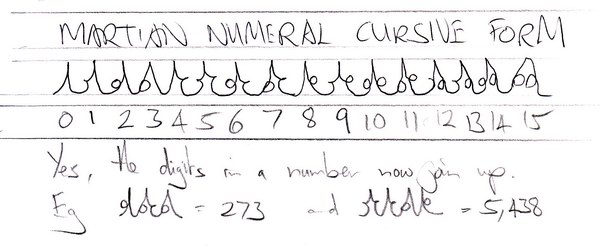
The Martian Numerals in cursive form (click for larger image).
String System
I could have stopped there but I also created another system,(in fact this was chronologically the first). This system is based on string, which can only form loops. It is not my preferred system but I include it just for the sake of completeness.
Voila! ![]()
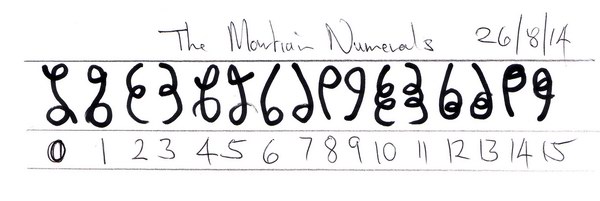
The Martian Numerals in string form (click for larger image).
So there you go: 3 new ways to write our numerals! The runic system should be used when carving and the cursive when writing. They exhibit a number of advantages over the incumbent system of the "West":
- They are harmonious in character. That is they look like they belong together, unlike the existing standard which is a real mish-mash.
- They are unambiguous. The current system has conflicts between numerals and letters, most notably between 0 and O, but there are also confusions between 1 & i, 2 & z, 5 & s, 6 & b and 9 & q.
- They are highly legible. Even when written badly you can expect to easily recognise the glyphs, even when mixed up with letters. The incumbent system is only highly legible when numerals are separated from letters. Hand written computer passwords are a case in point.
- They are reasonably efficient to write, although not as fast in most cases as the incumbent. However, you must remember that the incumbent system breaks the rules of unambiguity, legibility and consistent character in order to achieve maximum speed.
- When written, the digits may be joined together, just as characters are in a word. This enables a clear distinction between multi-digit numbers and an intuitive understanding of the difference between a digit and a numeral.
I commend them to you. Use them well.
![]()
Currently watching:
Die Hard With A Vengeance by John McTiernan
1 - After I had completed this system, (4 months later in fact), I was reading through some of the material on the Dozenal Society website and I came across this extensive set of Dozenal and Transdecimal Symbologies. You will note a system by Johnson that resembles mine. It doesn't appear to follow the binary metaphor however and it possibly only goes up to 11. You will also note an excellent system by Schumacher which is a rotation of my system, but it also makes the error of including the traditional "0". I was unaware of either of these at the time I was inventing mine.
2 - Yes, I am also working on the Martian Runic Alphabet...